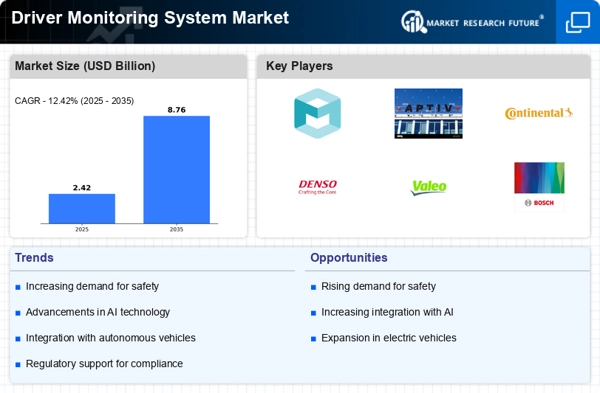Rising Incidence of Road Accidents
The Driver Monitoring System Market is significantly influenced by the rising incidence of road accidents, which has become a pressing global concern. Statistics indicate that distracted driving and driver fatigue are major contributors to these accidents, prompting a demand for effective monitoring solutions. In response, manufacturers are increasingly investing in driver monitoring technologies that can detect signs of distraction or drowsiness. Market forecasts suggest that the demand for these systems could lead to a growth rate of around 19% in the coming years. This focus on accident prevention not only addresses public safety concerns but also aligns with the automotive industry's commitment to reducing fatalities on the road. As such, the Driver Monitoring System Market is likely to expand in response to these urgent safety needs.
Consumer Demand for Enhanced Safety Features
The Driver Monitoring System Market is witnessing a surge in consumer demand for enhanced safety features in vehicles. As awareness of road safety issues grows, consumers are increasingly seeking vehicles equipped with advanced driver monitoring technologies. This trend is reflected in market data, which indicates that nearly 60% of consumers prioritize safety features when purchasing a vehicle. The integration of driver monitoring systems not only addresses consumer concerns but also aligns with the broader industry shift towards autonomous driving technologies. As manufacturers respond to this demand, the Driver Monitoring System Market is likely to expand, with projections indicating a potential market growth of 18% in the next few years. This consumer-driven shift underscores the importance of safety in automotive design and innovation.
Integration with Autonomous Driving Technologies
The Driver Monitoring System Market is increasingly intertwined with the development of autonomous driving technologies. As vehicles become more automated, the need for effective driver monitoring systems becomes paramount to ensure safety and compliance. These systems serve as a critical interface between human drivers and automated systems, providing real-time feedback on driver attentiveness and readiness to take control. Market analysis suggests that the integration of driver monitoring systems with autonomous technologies could lead to a market growth rate of approximately 22% over the next five years. This integration not only enhances safety but also fosters consumer confidence in autonomous vehicles, thereby driving the overall market forward. The Driver Monitoring System Market is thus positioned at the forefront of this technological evolution.
Regulatory Influence on Driver Monitoring Systems
The Driver Monitoring System Market is significantly shaped by regulatory influences aimed at enhancing road safety. Governments worldwide are implementing stringent regulations that mandate the inclusion of driver monitoring technologies in new vehicles. For example, certain regions have proposed legislation requiring systems that can detect driver impairment and alert authorities if necessary. This regulatory push is expected to drive the market, as manufacturers must comply with these new standards to remain competitive. The anticipated increase in regulatory requirements could lead to a market expansion, with estimates suggesting a potential increase in market size by 15% over the next five years. Consequently, the Driver Monitoring System Market is poised for growth as compliance becomes a critical factor for automotive manufacturers.
Technological Advancements in Driver Monitoring Systems
The Driver Monitoring System Market is experiencing rapid technological advancements, particularly in the integration of artificial intelligence and machine learning. These technologies enhance the ability to detect driver fatigue and distraction, thereby improving overall road safety. For instance, systems equipped with facial recognition and eye-tracking capabilities are becoming increasingly prevalent. According to recent data, the market for these advanced systems is projected to grow at a compound annual growth rate of over 20% in the coming years. This growth is driven by the increasing demand for smart vehicles and the need for enhanced safety features. As manufacturers continue to innovate, the Driver Monitoring System Market is likely to see a surge in adoption rates, making these technologies essential for modern automotive design.


















Leave a Comment